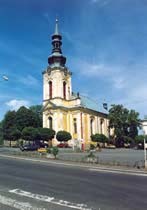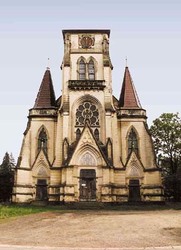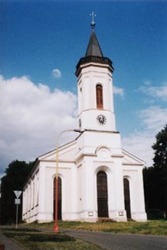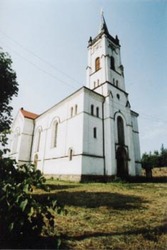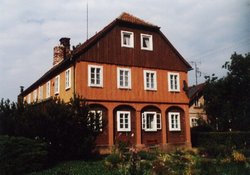Sights
The town of Varnsdorf lies at the foot of the Lusatian Mountains in the picturesque valley of the Mandava River, surrounded on 3 sides by the border with Germany. The first written records of the town date back to the first half of the 13th century. Thanks to its location, surrounding nature and rich cultural heritage, Varnsdorf attracts visitors from home and abroad. Tourists come here for the beauty of nature, interesting cultural monuments both in the town itself and in its surroundings.
Church of St. Peter and Paul (E. Beneš Square)
-
The Church of Saints Peter and Paul is the oldest church in Varnsdorf, built on the site of the original church from the 13th century. The foundation stone of the present church was laid in 1766. However, the construction was delayed by disputes in the village, and so it was not completed until 1774 to 1776, the late Baroque decoration was finished in 1777. The interior decoration is a mixture of Rococo and Classical styles. In 1904, a new organ was installed, built by organist Eul of Budyšín. In 1908, a new bell was consecrated and hung to replace the bell damaged by the summer storm of 1907. Above the side entrance is a memorial plaque commemorating the premiere of Beethoven's Missy Solemnis in 1830.
Interested in the history and legends associated with the church? Come and discover the original medieval atmosphere of this place and explore the secrets hidden behind its walls!
https://www.dekanstvi-varnsdorf.cz/
Church of St. Charles Borromeo (Karlova Street)
-
The foundation stone of this church was laid on 23 May 1904 and construction began the very next day. According to the design of the local architect Anton Möller, the construction proceeded very quickly: the same year it reached the height of the windows. Later, however, the pace of work slowed down. The church was consecrated on 3 September 1911. Its main tower was not completed because of the First World War, and so it is known locally as the "church without a tower".
Have you ever seen a church without a steeple? No? Then come and see it...
Old Catholic Church (Tyršova Street)
- The Old Catholic Church in Tyršova Street dates back to 1875. The Old Catholic Church itself was founded in Varnsdorf as a protest against the declaration of papal infallibility. The large bell is a gift of Raimund Artl. The alabaster statue and the relief of the Three Kings are the work of local artist Vincenc Pilz.
- Ing. Zeman, Tyršova 1320, tel. 372 468.
- Service: every Sunday at 9:00.
Neo-Gothic so-called Red Church ( T. G. Masaryka Street)
-
The church, also known as the Red Church, is the former neo-Gothic church of the German Evangelical Church in Varnsdorf. It is a unique sacral building made of glazed bricks, built using the foundation stone laid on 16 May 1904. The project was designed by architect Waldemar Kandler from Drazdan. The church was equipped with three bells, each bearing a symbolic inscription. These bells were a gift from the Upper Lusatian Gustav Adolf Association and rang for the first time on 28 June 1905. The church was consecrated on 3 December 1905 as the "Church of Peace" and on this occasion a tribute was paid to Emperor Joseph II for religious freedom. The organ, with 21 registers and 1300 pipes, was consecrated on 27 May 1906.
Come and join us in the mysterious atmosphere of this historic and symbolically rich church.
Church of St. Francis of Assisi (Studánka)
- The pseudo-Romanesque church of St. Francis of Assisi stands as a striking landmark in the village of Studánka near Rumburk. Its construction began in 1869 and it was consecrated on 13 October 1872. From January 1875 it served as a parish church, uniting the spiritual administration of the village, which was previously divided between the parishes of Dolní Podluží, Rumburk and Varnsdorf. After 1945, the church gradually began to deteriorate until the 1990s, when partial repairs were made to the exterior. Currently, more extensive repairs are underway to restore the church to its original splendour.
The Art Nouveau buildings date from the early 20th century - e.g. Legií Street and the Special School building in ul. T.G.Masaryka (originally a bank). Important Neo-Renaissance buildings include the school on Střelecka Street and the post office. Classical Empire style is represented among others by the house No. 512 on Národní Street. Villas in historicist styles can be seen in various places, e.g. on Seifertova and Tyršova streets.
Podstávkové (bandage) houses
Art Nouveau buildings date from the beginning of the 20th century, such as Legií Street and the building of the former Special School in T.G. Masaryka Street, which originally served as a bank. Important Neo-Renaissance buildings include the school on Střelecká Street and the post office. Classical Empire style is represented for example by the house No. 512 on Národní Street. Villas in the historicist style can also be found throughout the town, such as those on Seifertova and Tyršova Streets.
Elements of folk architecture can also be seen in Varnsdorf, such as the under-built houses, some of which are still decorated with remarkable stone portals. The listed buildings include
- the statue of St. Anthony at house No. 488 on Národní třída (a life-size sandstone statue on a richly decorated stone base)
- the statue of St. John of Nepomuk
- the Holy Trinity Column in ul. Pohraniční stráže,
- the monument by J. Horejc in the park on Národní Street.
Substation (bandage) houses

